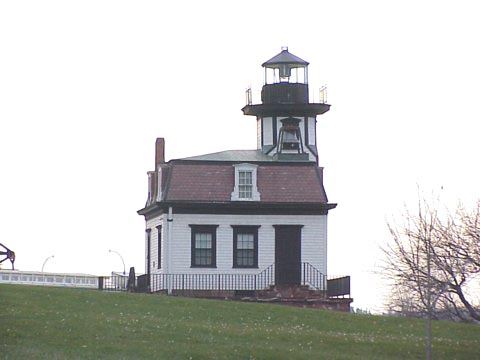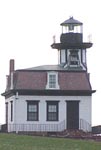|
Last Visited: November, 2002
History:
The Colchester Reef Light in Vermont was a lighthouse off Colchester Point (northwest of Burlington, Vermont) in Lake Champlain. It was moved to the Shelburne Museum in Shelburne, Vermont in 1956.
In 1869 the United States Lighthouse Service commissioned the building of the Colchester Reef Lighthouse on Lake Champlain to protect ships from the “Middle Bunch Reef,” comprising the Colchester Reef, the Colchester Shoals, and the Hogback Reef.
This lighthouse was one of a group of New England lighthouses built to the same plan. Nearly identical lighthouses were constructed at Sabin Point, Pomham Rocks, and Rose Island.
In the mid-nineteenth century, due in large part to the booming lumber business, which relied on easy shipping of raw timber from Canada to planing mills in western Vermont, commerce on Lake Champlain significantly increased. To protect ships in potentially hazardous waterways, the Lighthouse Service held a national competition for lighthouse designs, and Albert R. Dow, a Burlington native from the University of Vermont, won the commission. The Lighthouse Service implemented Dow’s designs in building the Colchester Reef Lighthouse, which marked the reef consisting of several groups of exposed rocks northwest of Colchester Point. It was completed in 1871.
Because the lighthouse needed to endure the lake’s strong winds and heavy winter ice-floes, Dow pegged and bolted together the lighthouse’s twenty-five-foot square stone foundation, post-and-beam frame and tower, and slate and tin roof. Dow then secured the entire building with one and a half inch thick iron rods to assure its stability. Despite Dow’s focus on the building’s framework, he ornamented his lighthouse with a mansard roof and scrolled window frames typical of the then-fashionable French Second Empire style. A sixth order Fresnel lens exhibited a fixed red light beginning in 1871.
The lighthouse served as both the home and workplace of eleven successive keepers and their families. The first floor was divided into a living room and kitchen and the second floor into four bedrooms. Coal stoves provided heat while large pumps retrieved water from the lake. The keepers used the nearby island to the north, Hogback Island, as farmland. The Island was auctioned off in 1956 after the lighthouse was decommissioned and was renamed Sunset Island.
The exposed location and northerly climate meant that ice figured heavily in incidents involving the lighthouse. In one instance, the keeper's wife went into labor in January 1888. Summoned by the fog bell, the doctor and his assistant attempted to cross the ice, but were blown north when it broke up, eventually landing safely at South Hero Island (also known as Grand Isle), four miles to the north. The baby was safely born with the father assisting alone.
In 1933 the Lighthouse Service decommissioned the Colchester Reef Lighthouse after the automatic electric beacon made the hand-operated system obsolete. Over the years the light suffered damage from ice floes and gradually fell into disrepair. Nineteen years later, in 1952, it was put up for auction and sold for $50, to be dismantled for timber. After this sale, Vermont historian Ralph Nading Hill ferried Electra Webb to the now-derelict lighthouse. Entranced, she persuaded the buyers to sell it for $1300 and substitute building materials. Webb purchased the lighthouse and had it moved to the museum grounds in the fall. Undaunted by the hazards involved, her veteran crew catalogued each piece of the building before moving the heavy beams, stairways, doors, and windows to reconstruct the building on museum grounds.
The Coast Guard donated the lens, fog bell, and striking mechanism, and in 2006 assisted with the mounting of a modern solar-powered beacon in the lantern, allowing the beacon to be lit for the first time since its decommissioning. With the house removed, a modern steel tower was mounted on the pier.
Source:
Wikipedia

Latitude/Longitude: 44.375308,-73.23135
Nearest Address: 5732 Shelburne Rd, Shelburne, VT
Directions:
- From Burlington take I-89 south to exit 13, I-189.
- Take I-189 for about 1 mile and take the exit for US 7. Take the exit for US 7 south.
- Once on US 7 south, take it into Shelburne. The museum will be on your right. If you don't want to pay the admission fee to enter the museum, or get there too late (like we did) you can see the lighthouse from US 7. Just pull off to the side of the road and snap a few photos. The ones you see on this page were taken from US 7. :-)
View Larger Map
|




